Planning marketing campaigns involves a lot of work, especially for agile marketing teams that are constantly mapping out new strategies and projects. Last year, Venture Harbour CEO Marcus Taylor published his ultimate marketing plan, including a free template that you can use and customise to create your own plans.
In this article, we’re looking at the best marketing planning software and tools that’ll help you put new strategies and campaigns together faster. We’ve tested dozens of marketing and project management systems over the years and changed software tools several times, as the needs of our team have evolved. This gives us a rounded understanding of what’s important when choosing a marketing planning tool and this guide will help you choose the perfect software for your team.
What are we looking at in this article?
This article is designed to help you choose the best marketing management software for your team. The bulk of this guide is reviews of the best tools we’ve used over the past five years but, before we get into our recommendations, we take some time to explain what marketing planning software is and the kind of features you should look out for.
Here’s a quick preview of what’s coming up in this article:
- What is marketing planning software? And how it’s different from project management software.
- Key features: What to look for in marketing planning software.
- TrueNorth review: The intelligent marketing planning system.
- MarketPlan.io review: The visual marketing planning system.
- CoSchedule review: Content marketing management and planning.
- monday.com review: Marketing workload planning and management.
- Airtable review: Build your own marketing management system.
- Trello review: The affordable Kanban marketing planner.
- ClickUp review: Collaborative marketing planning and management.
- Comparison: A head-to-head comparison to help you choose the best tool for your needs.
In each review, we look at the key features available, the pros and cons of each tool and how much you can expect to pay for them. Once we’re done with the individual product reviews, we wrap things up with a comparison section where we compare pricing, features and other factors so you can choose the best marketing planning software for your needs and budget.
First, though, let’s clarify what we’re talking about when we say marketing planning software and how this is different from other tools, such as project management software.
What is marketing planning software?
Marketing planning software is any tool that helps you plan campaigns and strategies more effectively. One thing we’ve found over the years is there’s an obvious lack of software designed specifically for marketing planning. Instead, we’ve got an endless supply of project management systems and marketing software tools designed for managing campaigns – some of which include marketing planning features to varying extents.
The problem is, while project management tools are often great for planning workloads and tasks, they’re not always so good at planning the more strategic elements of marketing strategies.
Generally speaking, marketing planning is a more collaborative process than workload planning and this is one area where project management software often falls short for marketing teams. When you’re putting a new marketing plan together, you need to compile your team, put your goals together, come up with campaign ideas and develop these ideas into working strategies and run the numbers to check your creatives are going to get results.
So you want a system that streamlines the creative process and provides the tools you need to develop ideas and predict outcomes. Once you’ve selected your best campaign ideas, you’re ready to start planning projects, workloads and tasks but the bulk of your marketing planning is already complete by this stage.
Marketing planning software should help you develop better marketing ideas and reach the scheduling stage of projects faster.
Once you get to this point, you need a system capable of running your campaigns and project management software is a capable tool for this. In recent years, a lot of project management software providers have added marketing planning features into their platforms to cater for both sides of the campaign planning and management process.
So some of the tools we’re looking at in this article are project management systems that have expanded into marketing planning tools over time.
This blurred line between marketing planning and project management can be a little confusing but the key is to understand which features you need from a platform. As long as you know what to look for on feature lists and pricing pages, you shouldn’t have any problems – so let’s talk about the key features to look for from a marketing planning tool.
Key features to look for in marketing planning software
The key thing to look for in marketing planning software is features and tools that will help you plan marketing campaigns and strategies more effectively. Unfortunately, a lot of providers (especially in the project management niche) talk about marketing planning as a use case for their software but lack the depth of features to make any real difference in the planning stage.
So here are some of the key features we want to see from a marketing planning tool.
Marketing goals & milestones
One of the first features to look out for in marketing planning software is the ability to set marketing goals and campaign milestones. This tells you that you can define marketing goals such as revenue targets, lead generation, conversion rates and other key targets as part of the planning process.
Many project management tools will let you set project goals but they don’t always include the most important marketing-specific goals like conversion rates or customer retention rates. These platforms will also lack the ability to track campaigns and measure results although you may be able to pull this functionality in through third-party integrations.
Unfortunately, comparing feature and integrations lists can be time-consuming but it’s worth checking that your software options provide what you need before putting any money on the line.
As a rough guide, look out for a marketing planning or project management tool that allows you to set marketing goals and campaign milestones or objectives. Campaign milestones are the incremental targets you need to hit in order to complete your wider marketing goals on time and setting these is a key step of campaign planning.
If a system supports both of these features, it suggests they’re making a real effort to help your marketing planning efforts.
Campaign simulation
Campaign simulation is an advanced marketing planning feature that predicts the outcome of your campaign ideas so you can select your best ideas and prioritise marketing actions. This will help you develop campaign ideas faster and with greater confidence by putting them to the test, refining your approach and checking campaigns stand a good chance of achieving your goals before you allocate any budget to them.
This isn’t a common feature in marketing planning software and only two of the options we’re looking at today offer any kind of campaign simulation features: TrueNorth and MarketPlan.io.
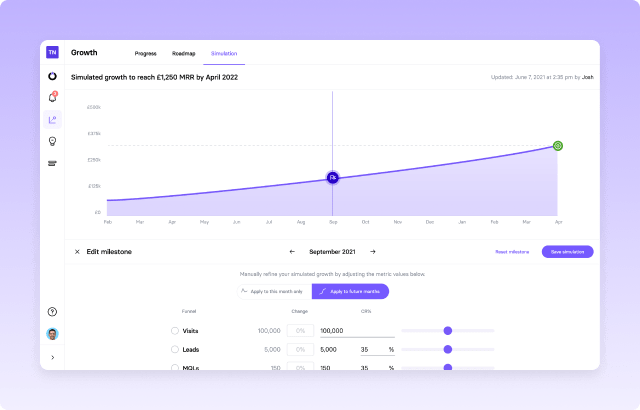
The simulation features in TrueNorth and MarketPlan.io are a little different and we’ll take a closer look at these in our review of each platform. At this stage, the more important point is that you’re only going to get campaign simulation from a serious marketing planning platform. And, if you’re getting this calibre of planning features from a software tool, it’s a strong indicator that you’re going to get the depth of other features you need to plan marketing strategies and campaigns.
Campaign management
A key stage of marketing planning is mapping out schedules, compiling your team and assigning tasks. Before any campaign or sprint begins, you want your roadmap fully arranged with every marketing action scheduled and your milestones set out for you to complete your goals on time.
At this point, we hit the overlap between marketing planning and campaign management.
As we explained earlier, there’s no shortage of project management systems available and most of them are capable when it comes to managing campaigns. As long as you can create teams, map out tasks in a schedule/timeline and assign tasks to groups and individuals, you’ve got the basics covered.
Ideally, you also want to be able to track the marketing goals and milestones you set, track campaign performance and reallocate budget as your campaigns progress. A real marketing management tool should give you ongoing control over campaign settings (schedules, budgets, milestones, etc.) as your campaigns run and the analytics tools to track and measure results along the way.
Marketing project templates
This is especially important if you’re using a project management system as a marketing planning tool. These platforms aren’t designed specifically for planning marketing strategies; they’re designed for running a wide range of product types and they may lack some of the marketing-specific features we’re looking at in this section.
For general project management systems, the very least you should look for is marketing templates for the most common project types: campaigns, content calendars and social media planners.
These templates will help you plan campaigns faster and partially make up for the lack of more advanced marketing planning features. So always check the library of templates available with project management systems and consider the depth of marketing templates on offer.
A platform that only provides a generic campaign template isn’t going to help much with planning but a library of templates for different campaigns and project types (content marketing, social media, email marketing, etc.) will make more of an impact.
Team collaboration features
Marketing planning is a collaborative process and you need a system that helps your team develop winning ideas. The depth of collaboration features you need depends on how your team operates. If you all work fixed hours in the same office location, then digital collaboration may be more of a convenience than an essential but for remote and flexible teams, these are crucial features.
The most common collaboration features to look out for are messaging, file sharing, roles, invites, tagging/mentions, video calls and notifications. Some marketing planning systems may also support meetings (scheduling, invites, group video, etc.), approvals, ideation and live document editing.
With collaboration features, it’s tempting to think more is better but we’ve found an excess of collaboration can actually interfere with progress. The most obvious example is team messaging and notifications, which can constantly interrupt the workflow of individuals and kill their productivity. Another problem you might run into with marketing planning is too many individuals working on a task that only requires the input of one or two people.
Keeping your marketing meetings productive is another big challenge, especially if people are underprepared when they attend. We’ve written a whole guide on how to keep marketing meetings productive and we’ve adopted a marketing planning tool that allows us to run meeting-less planning sessions to improve our productivity – something we’ll discuss in more detail later.
Automation
The main purpose of marketing planning software is to help you plan campaigns and strategies faster and automation is an important feature of any tool designed to save you time. Much like collaboration, the automation features provided by different platforms varies greatly and it’s not always a case of more features saving you more time.
Implementation is crucial when it comes to automation to ensure the features either save you time or enhance your ability to complete important tasks.
Keep in mind that automating marketing planning and project management are two very different things. project management systems are generally very capable of automating repetitive tasks like updating statuses, sending triggering notifications and moving tasks from one location to another.
However, this doesn’t necessarily mean you’re getting automation features that will specifically help with marketing planning. Keep this in mind when you’re looking at software options, especially if you’re considering project management systems to act as your marketing planning tool.
Campaign tracking & reporting
Another key attribute of marketing planning software is that you can track campaign performance. If you have a system that allows you to set marketing goals, milestones and track the performance of your strategies with native reporting, then you’ve got all of the basic essentials covered.
Ideally, you want a platform that either tracks data from your website directly or imports data through systems like Google Analytics.
When you’re looking at marketing planning tools, take a look at the reporting features available and check for website tracking, Google Analytics integrations and data import from key platforms like Facebook, LinkedIn, etc.
#1: TrueNorth: The intelligent marketing planning system
Pricing: $99/month (all features, unlimited users)
While most of the products we’re looking at in this article are project management systems that include varying features for marketing planning, TrueNorth is one of the only platforms on the market designed specifically for this purpose.
This is a specialist platform built by marketers for marketers that face the struggles of regularly planning and running marketing campaigns. TrueNorth was developed by agile marketers who constantly have to plan new campaign ideas for short marketing sprints and adapt their strategies.
Even if you’re not the most agile marketing team, TrueNorth is designed for the most demanding environments, cutting out the inefficiencies of meetings, ideation and the other planning essentials – so you can spend less time talking and more time doing.
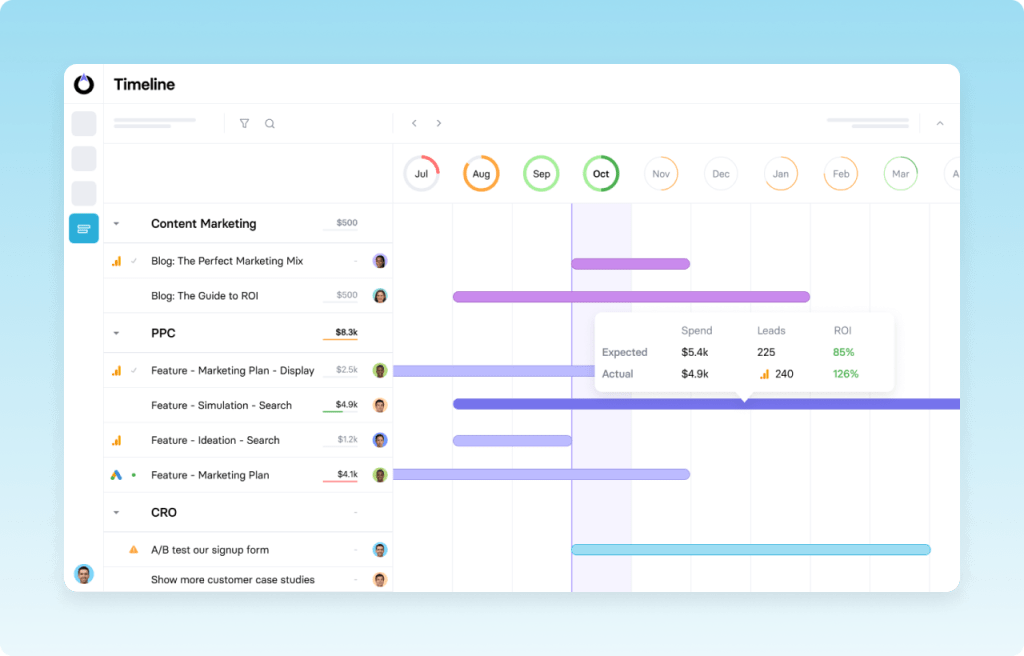
Key features:
- Campaign planning: Develop winning marketing ideas faster with built-in tools for each stage of the creative process.
- Marketing timeline: Map out your marketing timeline and assign tasks to get the best out of your team.
- Campaign tracking: Stay on top of everything with a single view. All campaigns – whether running now or upcoming – across all channels.
- Growth projection: Guide your team to the right decisions with data-driven predictions.
- Campaign simulator: Predict the outcome of campaign ideas and select the best strategies.
- Milestones: Set milestones for campaigns, based on data-driven projections, and optimise campaigns to constantly hit targets.
- Campaign reporting: Measure campaign performance vs simulations, make adjustments and resimulate to identify the changes that’ll maximise performance.
- Campaign ideation: Generate winning campaign ideas faster with collaborative ideation and simulation.
- Idea capture: Collect ideas from your team outside of meetings so you’re ready to develop the strongest concepts right away.
- Prioritise ideas: Quickly prioritise strategies and campaign ideas using the Impact, Confidence and Ease (ICE) framework, backed up by your data-driven campaign simulations.
- Historical comparisons: Compare new ideas with what you’ve tried before to build new campaigns based on what really works, not just gut feeling.
- Agile analytics: The Analytics interface makes it easier than ever to adapt fast when a campaign isn’t working – or double down when it is.
TrueNorth is designed to solve the challenges of marketing planning, one by one. It starts with an innovative collaboration system that promotes meeting-less ideation so you can generate a list of marketing ideas faster and have more to work with when you hold your first meeting – no more standing around and discussing the first thing that comes to mind.
Most project management systems offer collaboration features like team chat, file sharing and notifications but do these features really make your team more productive? In some ways, it depends on how you use them but we’ve had plenty of issues in the past with instant messaging, notifications and interruptions from “collaborative” software that hogs more time than it saves.
TrueNorth’s collaboration features are different. Marketing managers can invite team members to contribute marketing ideas ahead of time, allowing them to have a think and develop their own ideas without any pressure. Team members can invite colleagues to help with ideas or provide feedback. By the time you hold your first meeting, you have a list of marketing ideas to discuss and develop further – not rushed or on-the-spot ideas but quality marketing ideas that team members have properly considered.

This means you’re ready to start making progress in the first meeting and prioritise your best marketing ideas on day one.
TrueNorth’s next innovation is its campaign simulator tools which predict the outcome of your campaign ideas so you can prioritise your strategies – based on results, not intuition. All you have to do is set your goal, define your KPIs/metrics and apply campaign settings (budget, duration, etc.) and the simulator virtually runs your marketing ideas, using historical performance data, to predict their outcomes.
With the simulator, you can also edit campaign settings to understand what changes could help you achieve your goals. For example, if your campaign idea falls just short of hitting targets, you could see what happens when you increase budget, improve conversion rates or lift traffic numbers.
This allows you to forget the ideas that fall way short of your needs and tweak campaign ideas that have potential by pre-optimising settings before you put any budget on the line.
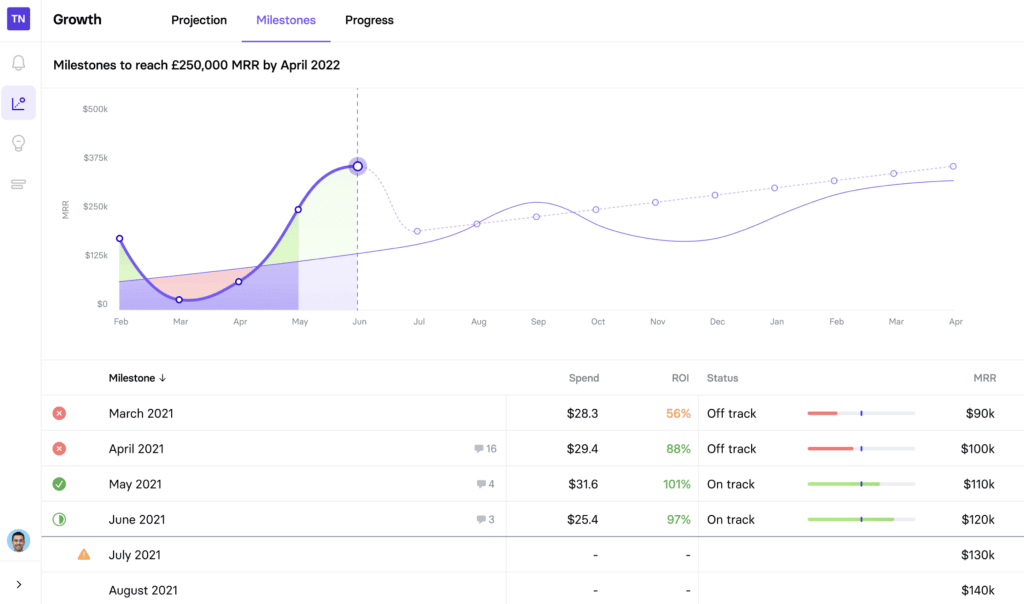
Once you run your campaign idea through the simulator, TrueNorth automatically prioritises your best ideas based on their outcomes and the ICE model (Impact, Confidence and Ease) so you can run with the campaigns that will have the highest impact with the resources at your disposal.
TrueNorth is the only marketing planning system to offer this depth of data-driven features to help you generate better marketing ideas and put them to the test before risking any of your marketing budget.
Instead of launching campaigns and waiting months to see if they’re hitting targets, you can simulate campaigns prior to launch and track live performance from the first day to see whether they’re on track to hit your milestones and goals. This means you can gauge performance faster and optimise campaigns that underperform as quickly as possible or increase budget on campaigns that are doing better than expected.
How much does TrueNorth cost?
TrueNorth is priced differently from other software products, too. Most platforms run multiple plans with different price points and charge on a per-user basis so your $30/month software fee jumps up to $150/month for five team members and even more once you upgrade to a more expensive plan.
With TrueNorth, you pay a flat $99/month fee for all of the features and unlimited users so you can get the most out of the platform as soon as you sign up.
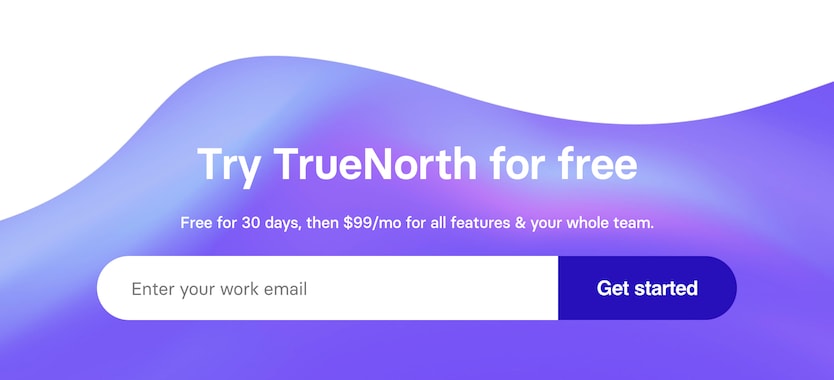
You don’t need to worry about choosing the right plan, upgrading your account or adding new team members – you pay the same monthly fee that you sign up for, no matter how big your team gets.
With TrueNorth’s pricing, you know exactly what you’re getting for your money and you’ll never get a surprise bill asking you for more money because you used a certain feature or added a new user account. The pricing model is also important for agile marketing teams because you want the flexibility to change your team from one project to the next without your software fees changing on a monthly basis.
You can even adapt your team on the fly (eg: bringing in a PPC expert at short notice) without facing a higher bill on the next invoice.
What is TrueNorth good for?
TrueNorth is one of the few genuine marketing planning platforms on the market with innovative features designed specifically to help you create and develop winning marketing ideas faster. Its ideation system encourages team members to come up with ideas and develop them before pitching them in meetings and the collaboration features are optimised to avoid interrupting colleagues’ workflows.
With the campaign simulator, you can test marketing ideas and develop them further to ensure your goals are both ambitious and achievable.
We spent years testing out different tools for marketing planning and one of them solved the most time-consuming issues we were facing, especially in the more creative and collaborative stages (eg: ideation, meetings, etc.).
TrueNorth not only allows us to plan marketing campaigns faster, but it also improves the quality of our campaigns with its data-driven simulation and testing features.
What is TrueNorth missing?
TrueNorth excels at marketing planning and the platform also carries over into marketing management with the timeline dashboard, campaign tracking and optimisation. As an all-in-one system for planning and managing your marketing strategy, TrueNorth delivers everything you need but this isn’t an all-purpose project management system.
Most of the products we’re looking at in this article are project management tools primarily designed for things like task management, team workloads and team analysis. This is because there is a serious lack of genuine marketing planning solutions while most of the leading project management software providers have implemented certain marketing planning features into their systems.
TrueNorth is a specialist marketing planning system and, in this regard, none of the project management tools can match it. The downside to this is, TrueNorth is limited to the scope of marketing planning and campaign management but this is the trademark of specialist tools that are designed to do specific jobs more effectively than general-purpose products.
TrueNorth pros & cons
TrueNorth pros
- Built for marketers by marketers: TrueNorth is the only dedicated marketing management software we’re aware of that’s built specifically for marketers, by marketers.
- Campaign simulator: TrueNorth’s innovative campaign simulator helps you prioritise campaign ideas, choose the best creatives and optimise performance with greater precision.
- Simple pricing: For $99/month, you get access to all of TrueNorth’s features for your entire team – no hidden fees, user-based pricing or upgrade expenses.
- Usability: TrueNorth is optimised to help you launch and optimise campaigns faster without spending unnecessary time fiddling with features and settings in the software.
TrueNorth cons
- Marketing focus: If you’re primarily looking for a project management system that moonlights as marketing management software, the other options in this list may be more suitable.
- No free plan: As part of TrueNorth’s simple, flat-rate pricing model, there’s no free plan available (but you can try it for 30 days, for free).
TrueNorth verdict
If you’re spending too much time on planning and not enough time on getting results, TrueNorth is the only software tool that tackles and overcomes the time-consuming challenges of marketing planning, one by one. If you need an all-purpose project management system, you’ll have to look elsewhere but it’s not like you have to choose between marketing planning and project management.
There is room for both types of software solutions but there are few tools specifically designed for marketing planning and TrueNorth offers up innovative features you’ll struggle to find elsewhere.
#2: MarketPlan.io: The visual marketing planning system
Free plan available; paid plans from $9/month
MarketPlan is the strongest rival to TrueNorth that we’re looking at today, in the sense that it’s a complete marketing planning system. However, it takes a different approach to strategic planning, focusing everything around the marketing funnel and its drag-and-drop funnel mapping tool.
In fact, MarketPlan is so good at funnel mapping that it features in our guide to the best funnel mapping tools as a top recommendation.
While the platform also incorporates Kanban and task management features, the platform centres around funnel mapping, the customer journey and visual planning. Like TrueNorth, MarketPlan also offers its own forecasting features (the only other platform in this list to do so) but, unlike TrueNorth, it incorporates funnel forecasting, as opposed to the campaign forecasting we looked at with TrueNorth.

Key features:
- Campaign planning: Visually plan campaigns with the same drag-and-drop builder.
- Funnel mapping: Build funnel maps with MarketPlan’s dedicated builder.
- Team collaboration: Send messages, leave comments and collaborate remotely on projects.
- Team chat: Chat with team members in real-time using MarketPlan’s instant messaging system.
- Cost & sales forecasting: Project funnel performance, campaign results, sales outcomes and expenses.
- Templates: Plan marketing projects faster with pre-built templates.
- Live analytics: Pull data in from Google Analytics and other sources for a live, all-in-one reporting system.
While TrueNorth is focused more on generating and testing better marketing ideas, MarketPlan is more of a visual planning tool that brings everything back to the funnel. So you don’t get the meeting-less ideation features or so much help with the creative collaboration stage of marketing planning but the drag-and-drop builder is an excellent tool for visually piecing together each part of your marketing strategy.
MarketPlan does offer a little more in terms of project management, though, which could negate the need to get another system for managing workloads once campaigns are live.
MarketPlan’s forecasting features are different from TrueNorth’s, too. TrueNorth’s campaign simulator helps you test campaign performance, prioritise your best marketing ideas and optimise settings before putting any marketing budget on the line. Meanwhile, MarketPlan’s forecasting features centre around the touchpoints of your marketing funnel.
How much does MarketPlan.io cost?
MarketPlan runs a free trial for individuals, which gives you access to almost all of its features, albeit with heavy restrictions. You’re limited to one user and a single marketing plan but you get full access to the funnel builder, forecasting and team management features.
The pricing starts to get a little more complex on the paid plans due to fees depending on the number of users and how many page views are connected to your marketing plans.
The Starter plan costs $9/month and this covers you for up to three users although you can pay for additional users at $3/month each. This also covers you for up to 10 marketing plans and you also get the full suite of collaboration features.

The Pro plan starts from $29/month for up to five users and 10,000 page views. Again, you can pay for additional user seats for an extra $3/month each. Page views are incrementally priced and you’ll have to keep an eye on your numbers to make sure you’re not going to get hit with a surprise bill.
When you look at the pricing details for additional page views, you can see how the monthly fees shoot up if you’ve got a high volume of traffic. Even for small companies, 10,000 monthly page views isn’t all that much, especially when none of the other platforms we’re looking at in this article charge for page views.

With this pricing model, you have to really know that MarketPlan is the platform for you but it helps that the free version gives you access to most of its features. This gives you a good chance to get to know the system at your own pace.
The issue with many free trials is they restrict features so much that you can’t get an accurate impression of the software without upgrading. While free trials can give you access to all of the features you want to test but only give you 14 days to make a decision, which is rarely enough for complete software tools.
MarketPlan achieves a great balance with its free plan by giving you access to most of the platform’s features so you can take as much time as you need to make a decision.
What is MarketPlan.io good for?
MarketPlan is excellent for mapping out marketing funnels and planning campaigns around the customer cycle. The platform is designed around the premise of visualising each touchpoint along the funnel and piecing together a marketing strategy that covers each interaction along the sales journey, nurturing leads and guiding them towards the next purchase.
If you want a visual platform to map your strategy out in this way, MarketPlan is an excellent choice.
Although MarketPlan takes a different approach to TrueNorth with campaign planning, it’s the only other platform in this article that offers comparable simulation and projection features. So, if you want a system that enables you to forecast the results of your marketing strategies, these are the two systems you want to compare.
What is MarketPlan.io missing?
If we continue with the TrueNorth comparison, the main area where MarketPlan falls short is features to help you create better marketing ideas, campaigns and strategies. TrueNorth’s collaborative ideation helps your team generate better ideas before the first meeting and its campaign simulator allows you to test, optimise and prioritise your best ideas before investing any marketing spend.
MarketPlan isn’t so interested in improving the quality of your marketing ideas or streamlining the first stage of planning. However, it is very capable at the testing and optimisation end of the strategic process and it also offers a marketing planning tool TrueNorth lacks: the funnel mapping tool.
We’ve also experienced some usability niggles with MarketPlan – mainly some UI quirks that a good update or two could probably solve. Speed could be more of an issue, though, especially when working on large plans as we experienced some slowdowns while trying to complete tasks.
MarketPlan.io pros & cons
MarketPlan.io pros
- Funnel mapping: An excellent funnel mapping tool that no other platform in this article offers.
- Projections: Predict the outcome of campaigns and optimise results ahead of launch.
- Reporting: MarketPlan’s analytics and integrations create a powerful reporting dashboard.
MarketPlan.io cons
- Complex pricing: The page view pricing system on the Pro and Agency plans could catch you out if you’re not aware of it.
- Speed: MarketPlan suffers some slowdowns, especially when working on large plans.
- Usability: Some minor UI and UX issues in the builder and software that could be solved with a good update.
MarketPlan.io verdict
MarketPlan is an excellent funnel mapping tool that encourages you to plan your marketing efforts around the customer journey. While it lacks a few early-stage planning features, the task management features available on all plans make it a capable all-in-one platform for the latter stages of marketing planning and campaign management.
The platform’s projection tools allow you to test out campaign ideas and project performance to make sure all of the important numbers add up. TrueNorth is the only other system offering comparable simulation features, although MarketPlan’s are more focused on optimisation than testing and prioritising marketing ideas. So it comes down to whether you value funnel mapping or campaign ideation more in your marketing planning strategy.
The other key factor with MarketPlan is pricing. The free plan gives you access to most of its features, albeit with heavy usage restrictions. However, the paid plans aren’t as affordable as they first appear once you understand the per-user and page view pricing model.
#3: CoSchedule: Content marketing management and planning
Free plan available; pricing from $29/month
CoSchedule is another specialist software tool that doesn’t quite fit into either category of marketing planning or project management while, at the same time, being a little bit of both. More specifically, it’s a content marketing management and planning system built around four main products:
- Calendar Organizer
- Content Organizer
- Work Organizer
- Asset Organizer
You can sign up for the Marketing Calendar as a standalone product, which includes a basic free version and a paid plan starting from $29/month or you can buy into the Marketing Suite plan to access all four of the products listed above and the full capabilities of CoSchedule’s software.
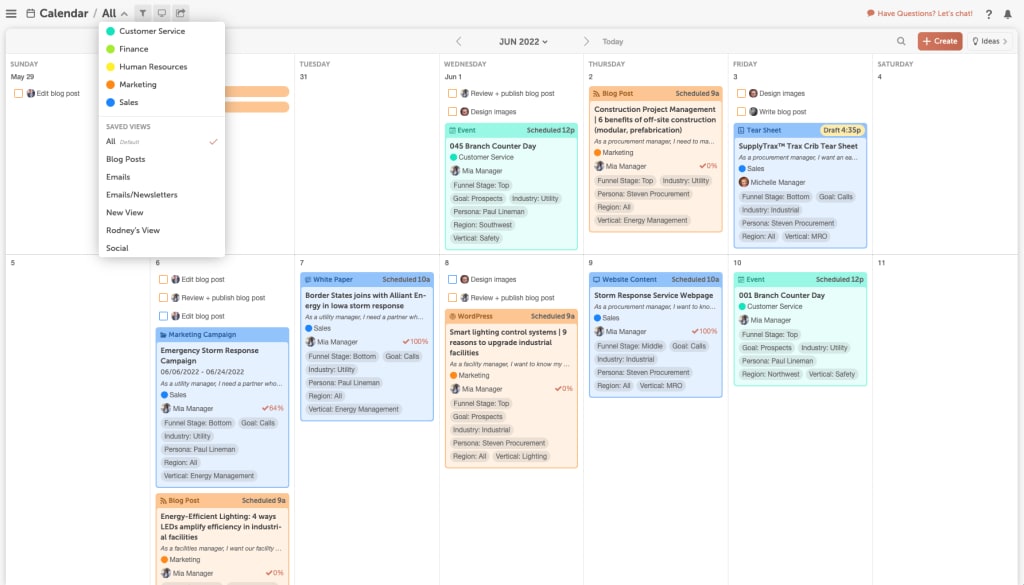
Key features:
- Content Calendar: Map out your content marketing strategy with CoSchedule’s trademark content calendar.
- Content Organizer: Create, schedule, publish and promote your content from one platform.
- Marketing projects: Manage marketing projects with tasks, workload management and collaboration.
- Automation: Automate repetitive tasks to speed up planning and project management.
- Social management: Manage your social media profiles and automatically publish content across profiles.
- Asset management: Store, index and collaborate on content assets in CoSchedule.
- Integrations: Extensive integrations with WordPress, Zapier, Google Docs, Mailchimp and plenty more.
CoSchedule’s Calendar Organizer is essentially a marketing calendar that you can use to schedule and manage your marketing activities. It’s primarily designed to act as a content calendar but you can map out other marketing and project activities alongside your content schedule instead of switching between multiple calendars.
This isn’t a fully-fledged project or task management tool but you can assign tasks to teams and individuals and schedule activities.
If you want more control over tasks and workload management, you’ll have to sign up for CoSchedule’s Marketing Suite to access the Work Organizer product, which allows you to manage the workloads of team members and manage projects in greater detail. You can schedule tasks, assign roles, prioritise tasks, manage deadlines and manage workloads to maximise productivity without overworking your team.
CoSchedule’s Work Organizer isn’t as advanced as some of the project management systems we’re looking at later but it covers enough of the basics to make the company’s Marketing Suite an effective all-round option.
With the Marketing Suite, you also get the Content Organizer to create, schedule and promote your content. The tool includes a text editor that you can use to create your content and collaborate on pieces with other team members. It also includes headline testing tools and scheduling so you can create a backlog of content and automatically publish on specific dates.
The fourth product in CoSchedule’s Marketing Suite is the Asset Organizer that creates a single space for managing and accessing content assets. You can upload assets like images, videos and data visualisations for team members to use in your content, giving access to everyone who needs it. This way, everyone knows where assets are and you can update or re-upload items to a single location to remove any risk of individuals using older versions.
How much does CoSchedule cost?
CoSchedule offers a free version of its Marketing Calendar product for individuals, limited to a single user for personal projects. Teams will need to purchase the Pro version of Marketing Calendar for $29/month per user and the Marketing Suite Business plan to get access to all of the company’s products.
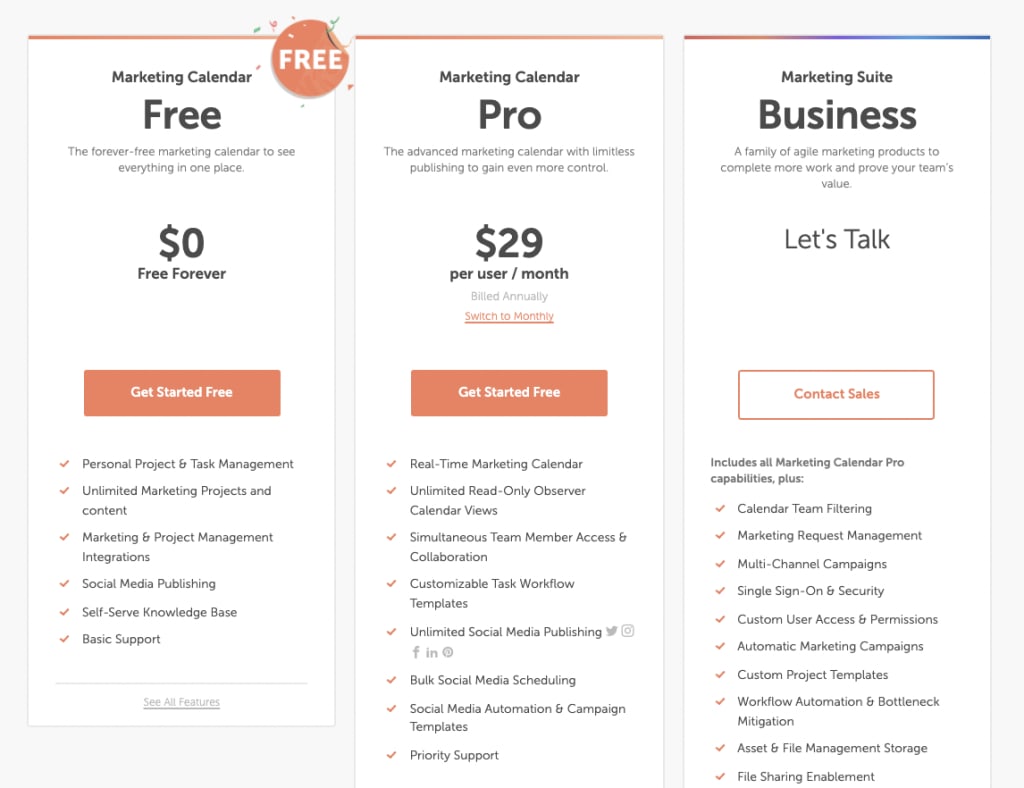
CoSchedule doesn’t publish any pricing details about its Marketing Suite Business plan so you’ll have to contact the company’s sales team to get a quote, based on the size of your team.
What is CoSchedule good for?
CoSchedule is a great option for content marketing teams, publishers and companies with a business model that revolves around content production. Few alternatives provide a set of tools for both (content) marketing planning and campaign management with specialist features like a text editor, content scheduling and asset management.
In truth, the free version of CoSchedule’s Marketing Calendar plan isn’t much use to content teams but the Pro plan brings in enough collaboration, automation and productivity tools to justify the $29/month (per user) asking price for teams that produce a lot of content.
Obviously, to get the best out of CoSchedule’s software, you’ll need to sign up for the Marketing Suite Business plan but the key question is how much you’ll have to pay for it.
What is CoSchedule missing?
The clear limitation with CoSchedule is that it’s designed for content teams and, while it’s a capable tool for content planning, its case weakens when it comes to planning and managing other strategies. We don’t have a problem with software providers specialising in certain strategies or roles but the question we have to ask is whether CoSchedule is specialist enough at its niche and delivers advanced features that justify paying for a content-centric platform.
If you’re looking for a more general-purpose marketing or project management system, you’ll probably want to look at some of the other options in this list. Aside from being very content focused, the task and workload management features are quite basic in comparison to the platforms we’re about to look at.
To be clear, you don’t get a lot of project management features on the standalone Content Organizer plans at all but, even with the Work Organizer product included in the Marketing Suite plan, you’re not getting the same depth of tools provided by the likes of monday.com and the other products coming up.
CoSchedule pros & cons
CoSchedule pros
- Content marketing: CoSchedule is primarily designed for planning and managing content marketing strategies – and it’s very good at it.
- Asset management: Having a single place to store and access all of your content assets boosts productivity and consistency.
- Usability: Strong UX design and the relative simplicity of CoSchedule’s software make the platform easy to implement and use.
CoSchedule cons
- Limited scope: The focus on content marketing limits CoSchedule for planning on other channels, such as PPC and paid social.
- Restrictive free plan: While CoSchedule offers a free plan for individuals, it’s so limited that it offers no real value beyond testing a restricted version of the platform – a free trial would be more helpful.
- Pricing: Considering the limited scope of CoSchedule’s software and the per-user pricing model, a $29/month starting price is pretty expensive for marketing teams.
CoSchedule verdict
For content marketing teams or companies that prioritise content publishing, CoSchedule offers a solid system for planning and managing campaigns. It offers specialist tools you won’t find on the other platforms we’re looking at today, including collaborative text editors, headline scoring and asset management, that will help teams create quality content on a regular basis.
The emphasis on content marketing is pretty obvious and CoSchedule isn’t going to replace a project management system or a multichannel planning tool. This is a product that specialises in one channel so it all comes down to how important content marketing is to your team/business and whether you’re struggling to create a constant stream of high-quality content without a tool like CoSchedule.
#4: monday.com: Marketing workload planning & management
Free plan available; paid plans start from £21/month*
If TrueNorth and CoSchedule are too light on task management features for you, monday.com is worth taking a look at. Primarily a project management system, monday.com is designed to manage the workloads of teams and individuals across a wide range of projects – from marketing campaigns and software development to recruitment and customer onboarding.
The downside is monday.com offers fewer features and tools for marketing planning, specifically. You certainly don’t get the meeting-less ideation or campaign simulation features offered by TureNorth or the content planning tools provided by CoSchedule.
However, monday.com does include a library of 200+ project templates to speed up the planning process, including a dozen marketing-specific templates: content calendar, marketing strategy, social media planner, campaign planning and more.
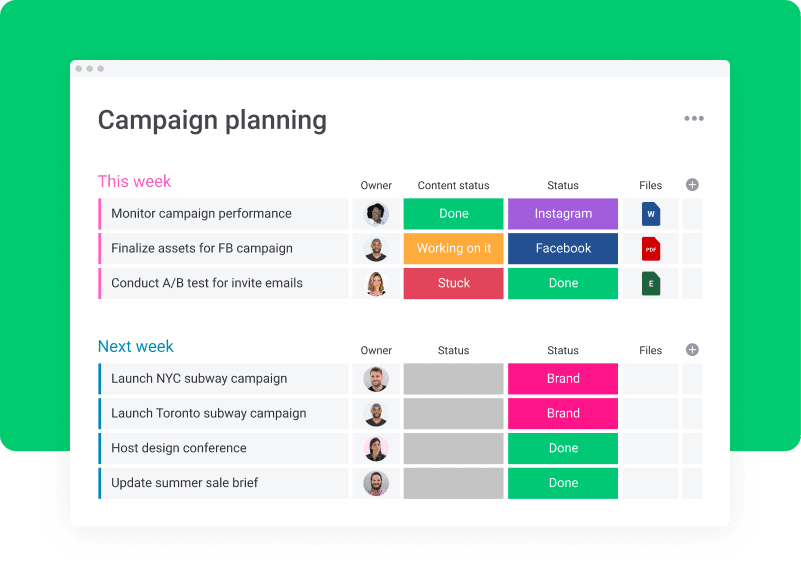
Key features:
- Project management: Manage projects, including marketing campaigns, product launches and more.
- Campaign planning: Plan your marketing campaigns in one organised workspace.
- Task management: Manage tasks at the team and individual levels throughout your campaigns.
- Advanced views: View and manage projects across multiple views, including Kanban, timeline, calendar, Gantt, map view and more.
- Content calendar: From digital publications to social media, manage your publishing schedules and coordinate all content initiatives in one visual calendar.
- Automation: Automate repetitive work by setting customisable actions in your boards.
- Performance insights: Visualise project performance and workflows so you know what’s working and what’s not.
- Time tracking: Track and monitor the time spent on each task.
- Templates: Use and create project templates to get things moving faster.
- Collaboration: Send messages, attach files, run video chats and collaborate via digital whiteboards.
Aside from the dozen or so marketing templates in its library, monday.com doesn’t offer any other features specifically for marketing planning. Despite this, the platform is a great tool for planning project timelines, schedules and workloads – both for teams, individuals and groups within your team.
Depending on which plan you’re signed up to, you also get extensive view options for planning and managing your products, including the standard Kanban view, a timeline view, calendar, a workload view and more.
This will definitely help you plan campaigns and other projects but the views are also designed for team members to access and manage their individual workloads. You can assign tasks, set deadlines, upload attachments and map out workloads to ensure everyone has enough time to complete the tasks assigned to them.
Team members can, then, access their schedules, send messages, upload their own attachments and update task statuses. Individuals and groups can also collaborate through messaging, attachments, video calls and a built-in collaboration whiteboard.
How much does monday.com cost?
Pricing is where things start to get a little complex with monday.com and we’ve got five different plans to talk about in this section. First, we’ve got the free Individual plan that covers you for two user seats, 1,000 “items” (projects, tasks, customers, etc.) and the standard Kanban view.
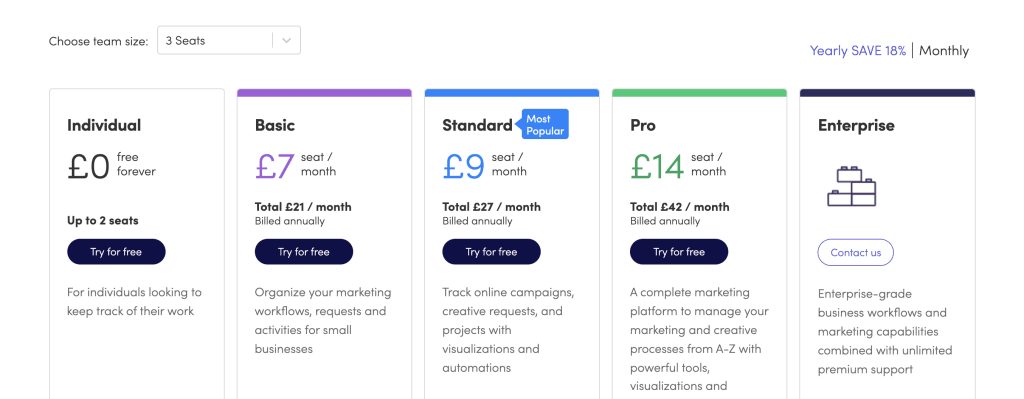
An upgrade to the £7/month* (per seat) Basic plan gets you unlimited items and allows you to invite an unlimited number of viewers to access your account on a view-only basis. There’s a reason why I’ve put an asterisk next to the £7/month detail, though. That’s because you’re obliged to sign up to a minimum of three users on monday.com’s paid plans so you’re looking at a starting price of £21/month for three user seats on the Basic plan.
Something else to keep in mind is that team sizes are restricted to certain numbers( 3, 5, 10, 15, 20, 25, 30 and 40) so you can end up paying for seats you don’t need and the extra expense can be significant on the more expensive plans, especially for larger teams.
What is monday.com good for?
Clearly, monday.com’s biggest strengths are project and workload management but it’s worth acknowledging how important this is in marketing planning. This platform isn’t going to help you with the more strategic aspects of planning campaigns but it will help you put together schedules that make the best use of your resources and maximise productivity without overworking team members.
This helps marketing managers during the planning stage but the same functionality helps the whole team manage their workloads as campaigns and other projects progress.
For remote teams and companies operating under flexible working, the cross-platform architecture is a big strength, too. With the web app, team members can access the platform from any browser and the mobile apps for iOS and Android put monday.com in the pockets of team members wherever they go. The experience between platforms is seamless, meaning team members can move between devices without any inconsistencies.
What is monday.com missing?
As the focus of this article is marketing planning and we’ve already looked at a couple of tools that provide specialist features for strategic planning, this is the key area where monday.com falls short.
This isn’t a comparable tool to TrueNorth or CoSchedule and you’re not getting anything that will help you come up with better marketing ideas. Instead, you get a comprehensive project management system that excels at planning schedules, workloads and tasks.
This carries over into running projects, which is the primary purpose of monday.com but the focus on updating task statuses in the software forces team members to spend more time interacting with the platform than we would like at times. Depending on which plan you’re signed up for, you can overcome some of this with automation workflows but it’s difficult to escape the manual status updates.
monday.com pros & cons
monday.com pros
- Task management: monday.com prioritises task management, building your projects around individual task lists.
- Visual simplicity: The interface is a little harsh on the eyes but its visual simplicity communicates information effectively.
- Collaboration: The in-app notes, messaging and notification system aids collaboration without being intrusive on individual workflows.
monday.com cons
- Time-consuming: While monday.com is excellent for task management, you spend a lot of time creating task lists, structuring projects and updating statuses.
- Lack of marketing features: This is a great tool for planning schedules and workloads but it offers few marketing-specific features for the more strategic aspects of campaign planning.
- Complicated pricing: The monthly prices displayed on the website are a little misleading because you have to pay for a minimum of three users and the per-user pricing multiplies the total fee.
monday.com verdict
If you’re more interested in planning marketing schedules and the workloads of your team, monday.com is an excellent option. Aside from the dozen or so marketing templates, you’re not getting much in the way of marketing-specific features and you’re certainly not getting the advanced planning features provided by TrueNorth or, to a lesser extent, CoSchedule.
However, monday.com is an excellent tool for planning campaign timelines and the workloads of team members to strike the right balance between maximising productivity and avoiding burnout. Depending on your priorities, what it lacks in marketing features, it could make up for – at least in part – with its flexibility for managing a wider range of projects.
As so often is the case with making software choices, a lot of it comes down to whether you want the specialist marketing planning system (TrueNorth) or a more general-purpose project planning and management platform.
#5: Airtable: Build your own marketing management system
Free plan available; pricing from $10/month
Airtable is a database visualisation tool that enhances the traditional spreadsheet interface into an advanced project management tool. The platform allows you to build custom interfaces and pull data in from other platforms to give team members all of the information and assets they need to perform their roles.
The open nature of the system allows you to plan and manage campaigns on your own terms and this freedom is a key characteristic of Airtable. The downside to this is that you have to put time into setting up and customising your interfaces although Airtable’s marketing templates can get you there faster, including templates for content operations, campaign management, a social media calendar and product launches.
The architecture may not appeal to everyone but marketing teams and developers that appreciate the databasing approach to marketing planning and management will want to take a look at Airtable.

Key features:
- Build your own system: Airtable allows you to build your own marketing planning and management system.
- Campaign planning: Map out marketing actions, workloads and assets throughout the campaign schedule.
- Content calendar: Create content calendars and manage your strategy as things develop.
- Collaboration: Easily attach videos and images and work through feedback directly in Airtable.
- Asset management: Upload assets, provide access to everyone who needs them and track usage.
- Automation: Trigger notifications, streamline redundant work, integrate your tools, run custom code and more.
- Marketing templates: Plan marketing campaigns faster using Airtable’s library of templates.
- Interface Designer: Build your own interactive interfaces to customise workflows for your team.
- Reporting: Build your own reports and compile all of the data you need without writing any code.
You have to invest time into Airtable to get the best out of its platform but it rewards you with the freedom to create and import the data you want to work with. The Interface Designer also gives you the freedom to visualise this data and work with it however you like.
You can pretty much build your own campaign planning system in Airtable and, then, build your own campaign management workflow with a campaign tracker, content assets, budgeting and campaign reports – or whatever else you need.
As long as you and your team are comfortable working with the databasing format and set process involved, Airtable basically allows you to create the marketing planning and management system you want.
How much does Airtable cost?
Aitable’s pricing model is less complex than monday.com’s with a basic free plan available for up to five users and three paid plans: Plus, Pro and Enterprise. The Plus plan costs $10/month per user with no minimum user requirement and the Pro plan bumps your bill up to $20/month per user, provided you pay for the first 12 months up-front.
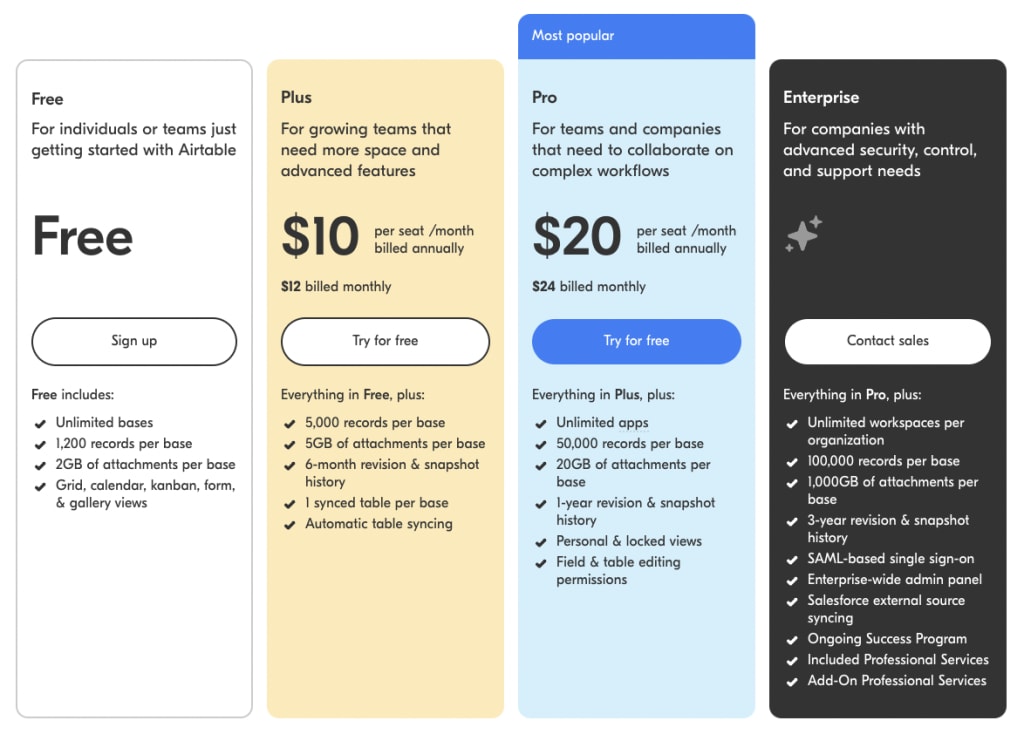
The pricing may be simple enough but the feature distribution across them is more complex, which makes it difficult to know what you’re signing up to at first. The infrastructure of Airtable’s software makes this a little trickier, too, as the platform is built around workspaces, bases, tables, records and apps – and it’s hard to know how much of each you’re going to need until you have experience with the platform.
Perhaps Airtable could simplify the feature distribution across plans to make it a little easier to understand what you’re getting into before signing up but it’s not easy to split a system like this across several plans.
Crucially, Airtable offers a free plan that allows you to work with unlimited bases and get used to the limitations of records per base, attachments per base and the overall architecture. Once you get used to using the free version of Airtable, you should have a better idea of what each of the paid plans is offering and whether the platform is right for your team.
What is Aitrable good for?
Airtable takes the classic spreadsheet format and enhances it as a databasing tool with tools to help you complete project management tasks faster. Its biggest strength is giving you the freedom to create your own interfaces, import the data you need and create reports that show insights in the most relevant way to your team.
With most project management tools, you’re limited to the interfaces built into each platform and, although you get a certain amount of room for customisation, Airtable allows you to build your own interfaces from scratch.
You can also use Airtable’s templates to get a headstart and customise the pre-built interfaces to match your needs. Provided you have a clear vision of how you want to plan and manage your marketing campaigns, Airtable makes it fast and easy to build basically any workflow you can imagine.
What is Airtable missing?
Airtable is an ambitious software platform that tries to simplify advanced databasing as a project management tool. It does a remarkable job, too, especially when you consider the open nature of its system and how much room it gives users to create their own workflows.
In many ways, Airtable’s biggest problem is the complexity of what it does. If you visit the company’s website for the first time, you’re probably not going to get a clear idea of what the platform’s about by simply reading the page copy. As we mentioned earlier, it’s a similar story on the pricing page where it’s difficult to gauge what you’re getting from each plan unless you already know a bit about the software.
Unless you’ve got experience with similar databasing tools, the only way new users are going to get familiar with Airtable is by signing up for the free plan and getting to know it for themselves.
This is a system you have to invest time into to find out whether it’s right for you or not – and it’s not going to be right for everyone. If you’re looking for a system that’s ready to set up and use, this isn’t it. And, if you’re not keen on the databasing approach (this requires experience or willingness to learn), then Aitrable definitely isn’t for you.
On the other hand, if you find most project management systems too inflexible, Airtable provides a more open alternative for those familiar with databasing or willing to learn.
Airtable pros & cons
Airtable pros
- Flexibility: Airtable’s open databasing system gives you the freedom to build workflows, interfaces and processes on your own terms.
- Interface Builder: The drag-and-drop Interface Builder gives you code-free control over UI elements and your data.
- Data import: Excellent integrations and data import options give you a wealth of insights to work with.
Airtable cons
- Limited planning features: Airtable prioritises process and task management more than marketing planning.
- Time-consuming: You have to put time into this platform, even if you’re already familiar with databasing systems.
- Complexity: Flexibility comes at a price and Airtable is the most complex platform we’re looking at in this article.
Airtable verdict
If you’re looking to build your own marketing management platform without developing the whole system yourself, Airtable provides a simple, code-free environment to do this. As long as you have a clear idea of what you’re trying to achieve with Airtable and you’re willing to put the time into building it, you can develop and optimise the ideal marketing planning tool for your team.
While there are some limitations (especially in native marketing planning features), Airtable gives you plenty of freedom while making it relatively easy to build interfaces and piece together a complete marketing management system.
#6: Trello: The affordable Kanban marketing planner
Free plan available; pricing from $5/month
If Airtable is the most complex tool we’re looking at today, Trello has got to be the simplest and also one of the most affordable. The platform is designed around an adapted version of the Kanban approach to visualising project management. It incorporates a system of workspaces containing boards, which themselves contain cards or lists of cards that you can create as tasks and assign to individuals or teams.
You can use this to group tasks together by category or status, such as “To Do,” “Doing” and “Done,” as shown in the visualisation below. Within cards, you can set deadlines and reminders, attach files, add checklists, leave comments, provide feedback and collaborate with teammates.
It’s a simple platform but a generous free plan and affordable pricing across the board makes this a compelling, flexible planning tool for marketing teams on a budget.
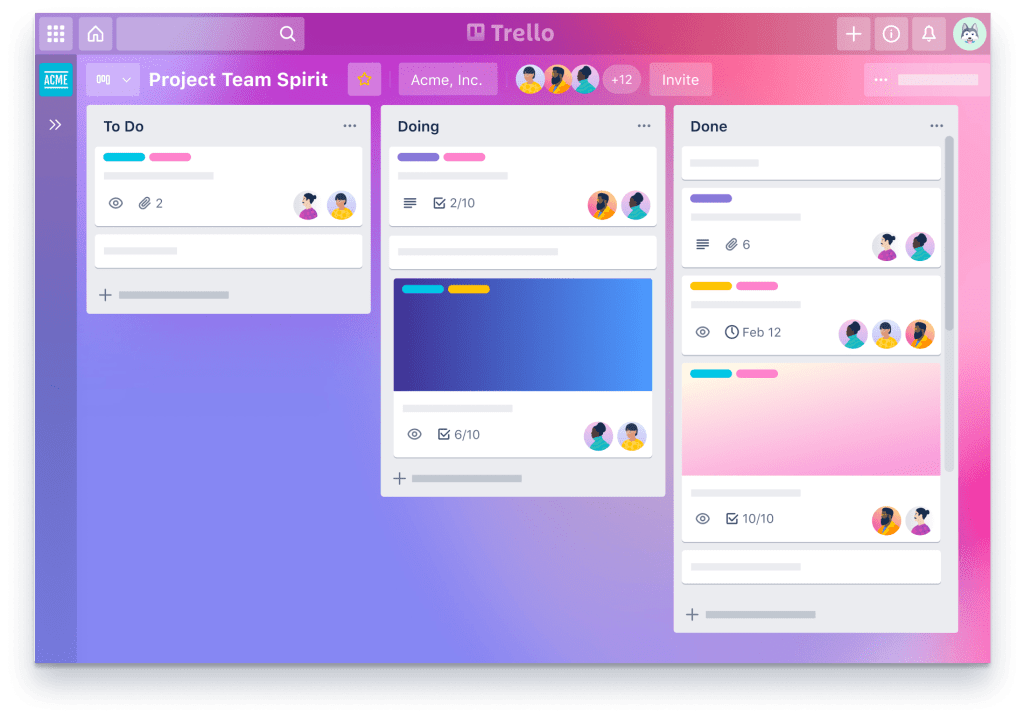
Key features:
- Trello boards: Plan campaigns with Trello’s signature boards interface, an enhanced version of the classic Kanban format.
- Campaign planning: Map campaigns and workloads in boards, timelines, calendars and other views.
- Project management: Run projects from start to finish and quickly adapt to agile environments.
- Task management: Use lists, cards and checklists to create, assign and manage tasks.
- Workload management: Create and manage workloads, assign tasks and update statuses.
- Templates: Plan campaigns and projects faster by using Trello’s template library.
- Automation: Create rules, buttons, and commands to automate almost any action.
On the Free and Standard Trello plans, you have to take charge of planning your campaigns as you only get access to the standard board view. This means you can’t plan campaign schedules as effectively as you can with timeline and calendar views but both of these are available on the Premium and Enterprise plans, as well as a new Workspace Table view and a Map view.
Templates are also reserved for the Premium and Enterprise plan and the library currently includes 26 marketing templates to help you plan projects faster.
Without the advanced views and templates, you’re not getting much in the way of marketing planning features on the Free or Standard plans – other than Trello’s basic project planning interface. Then again, even on the Free plan, you can create unlimited cards, add up to 10 boards to each workspace and manage tasks while the Standard plan also gives you Unlimited boards, custom fields and a bunch of other features.
Each plan supports automation to help you improve the efficiency of your team, allowing you to automate actions like task updates. The number of command runs you can perform each month varies on the Free and Standard plan but you get unlimited runs once you upgrade to the Premium plan.
How much does Trello cost?
Trello’s generous Free plan costs exactly $0/month and it doesn’t matter how many people are on your team. You’re simply limited to the number of boards you can create per workspace and other usage limits. The Standard plan lifts some of these restrictions for an asking price of $5/month per user but you get the best out of Trello by signing up for the Premium or Enterprise plan.
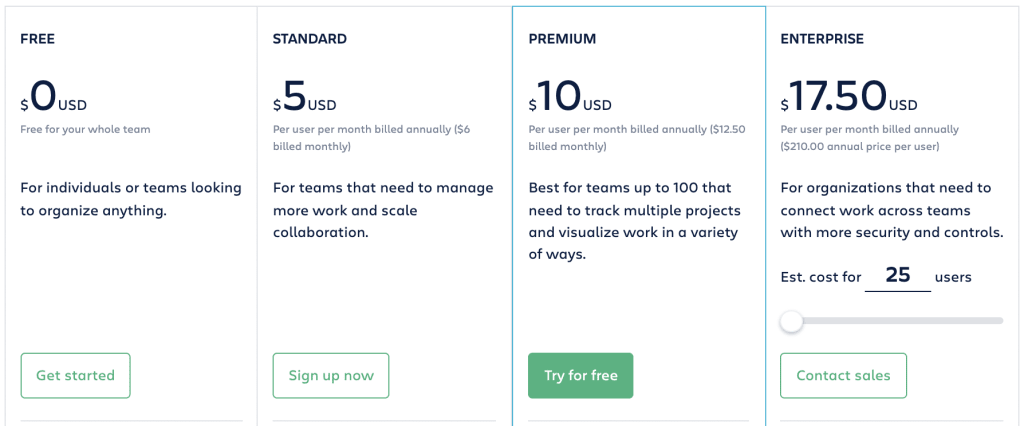
For $10/month per user, the Premium plan opens up five additional views: Dashboard view, Timeline view, Workspace Table view, Calendar view and Map view. The timeline and calendar view are particularly helpful for planning out marketing schedules, workloads and campaigns (eg: a content calendar) while the standard Trello view helps you and your team manage tasks as the campaign runs.
By the time you upgrade to the Premium plan, you can invite non-users into your projects on a view-only basis and group boards together in collections. You also get priority support and enterprise-level admin features (eg: domain restricted invites, deactivating users, etc.).
The Enterprise plan starts at $17.50/month per user for teams of 25 and the per-user price gradually drops for each team member over 250 (but only by 1¢ each). Still, these are affordable per-user fees for an Enterprise plan, even if Trello is a relatively simple project management tool.
That said, even at these prices, you’ll be paying more for Trello’s Enterprise plan with a team of six ($105/month) than you’ll be paying for TrueNorth’s entire marketing planning system ($99/month), regardless of how big your team is.
What is Trello good for?
Trello is excellent if you’re looking for a free or affordable project management tool for small teams. It’s not as polished as platforms like monday.com but even the paid plans are significantly more affordable. With the $10/month per user Premium plan, you get a basic but useful campaign planning tool, thanks to the inclusion of a timeline view, which helps you plan out campaign schedules.
The calendar view also helps you plan out content schedules while the marketing templates can give you a head start with campaign planning (they are very basic, though).
Simplicity is the common theme with Trello and, despite some limitations, the platform benefits from an excellent UX that makes it easy for anyone to sign up and start using right away. The cross-platform architecture is as good as it gets, too, with mobile apps for iOS and Android complementing browser-specific apps for Chrome, Firefox, Edge and Safari – in addition to the standard web app that anyone can access via Trello.com.
What is Trello missing?
Trello doesn’t offer up anything new in terms of marketing planning or project management and it’s not going to transform the way your team works. If you’re signed up for the Premium or Enterprise plans, then the timeline and calendar views will help you plan campaign schedules and the marketing templates might help you put plans together faster, but that’s all you can expect from Trello.
You’re not getting anything that helps your team produce better marketing ideas or develop creatives more effectively, even on the Enterprise plan. The platform simply isn’t designed to handle the more creative aspects of marketing planning but it doesn’t make any false claims about it, either.
Trello pros & cons
Trello pros
- Free plan: Trello’s generous free plan is open for teams of all sizes.
- Affordable: Paid plans are affordable across the board, especially for smaller teams.
- Usability: Trello is easy to use and provides an excellent cross-platform experience.
Trello cons
- Limited features: Trello’s obvious drawback is the simplicity of its platform.
- Restricted views: Without the timeline and calendar views available on the Premium and Enterprise plans, Trello’s prospects as a marketing planning tool are weak.
Trello verdict
Trello’s freemium product strategy has won the hearts of many and it’s a great option for marketing teams that need a free or affordable option until they’re ready to pay for something more comprehensive. As a project management tool, it’s difficult to criticise Trello’s product design and pricing model but the issue for marketing planning is the restriction of timeline and calendar views only being available on the Premium and Enterprise plan.
If the timeline view was available on the free plan and other restrictions we put in place to balance this, our verdict would look very different. Even if the timeline view was available on the Standard plan, the easier upgrade path would make Trello a top recommendation for marketing planning at the $5/month per user price point. Obviously, the company has to monetise its product somehow and its priority is clearly project management – not marketing planning – but we’ve got to stay relevant to the purpose of this article.
#7: ClickUp: Collaborative marketing planning & management
Free plan available; pricing from $5/month
Our final recommendation is the ultra-collaborative ClickUp that aims to provide an all-in-one project management system. The platform also offers specialist features for marketing planning, including a dedicated tool for sprint planning, goal tracking, resource management and plenty more.
While it doesn’t have a specific tool for marketing ideation, ClickUp’s collaborative chat system, docs features and task management capabilities combine to create a useful environment for marketing teams to refine campaign ideas.
Excellent UI design makes a depth of features easy to navigate and ClickUp also allows you to customise interfaces and dashboards without writing any code. This means you can build the system to meet the needs of your team and switch off any features you don’t want getting in the way.
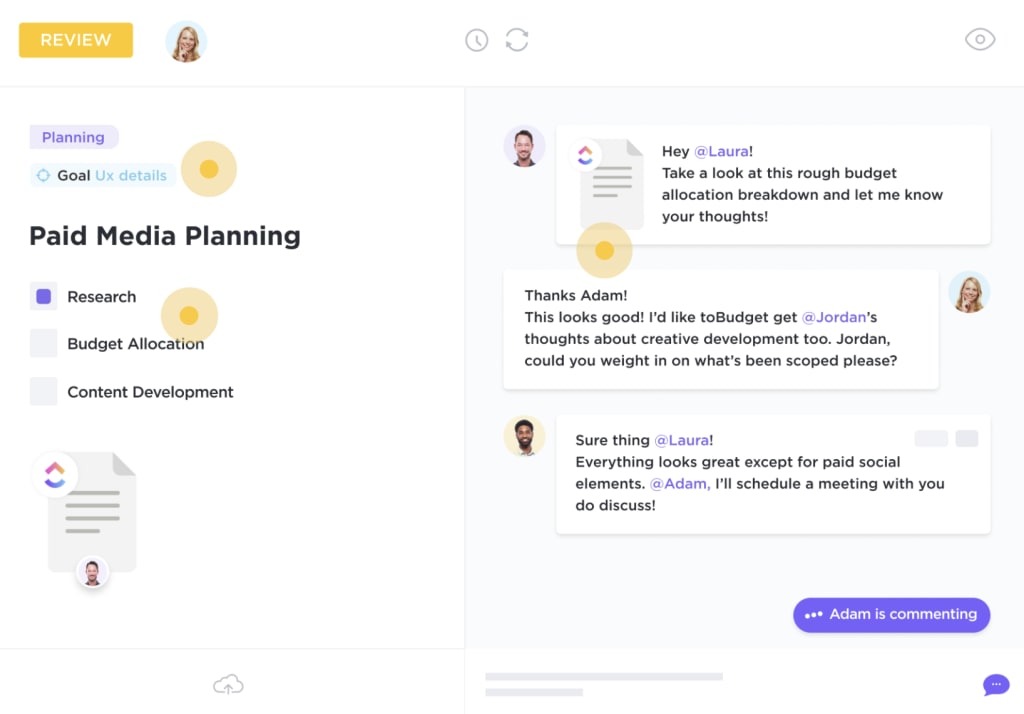
Key features:
- Project planning: Plan campaigns and other projects with ClickUp’s collaborative system.
- Task management: Create and manage tasks for teams and individuals.
- Spaces: Organise teams and departments into Spaces where you can group projects into folders.
- Views: Plan and manage your campaigns across 15 different views, including lists, boards, calendars and more.
- Collaboration: Plan and manage projects at every level as a team with email, chat, comments, docs collaboration and more.
- ClickUp Docs: Create, manage and collaborate on documents inside ClickUp.
- Reporting: Set goals and track progress with built-in reporting.
- Time management: Track time, estimate tasks durations and analyse team performance.
- Marketing templates: Plan campaigns and marketing projects faster with ClickUp’s library of templates.
- Automation: Cut out repetitive tasks using 50+ actions, triggers and conditions with pre-built, customisable recipes.
At its core, ClickUp is a project management system that aims to be so much more but it has to deliver the core features you would expect from a platform designed to manage a variety of projects. It offers more views than any other tools we’ve looked at in this article – a grand total of 15, including Kanban, timeline, calendar, list, Gantt, workload and more.
These views help you plan marketing projects, piece together timelines and map out workloads to hit your targets while avoiding burnout. ClickUp also comes with a library of templates to help you plan projects, including seven marketing templates and several templates for agile projects. This includes a few sprint templates and ClickUp even has a dedicated tool for planning sprint runs, which you can use to set goals, define sprint dates, mark priorities and track team progress.
How much does ClickUp cost?
ClickUp offers a free plan for individual users that works fine as a personal project management tool but this is a collaborative platform designed for teams. Paid plans start from $5/month per user, which puts ClickUp among the more affordable platforms we’ve looked at in this article – only TrueNorth is cheaper for more than 5-10 team members, depending on which plan you sign up for.
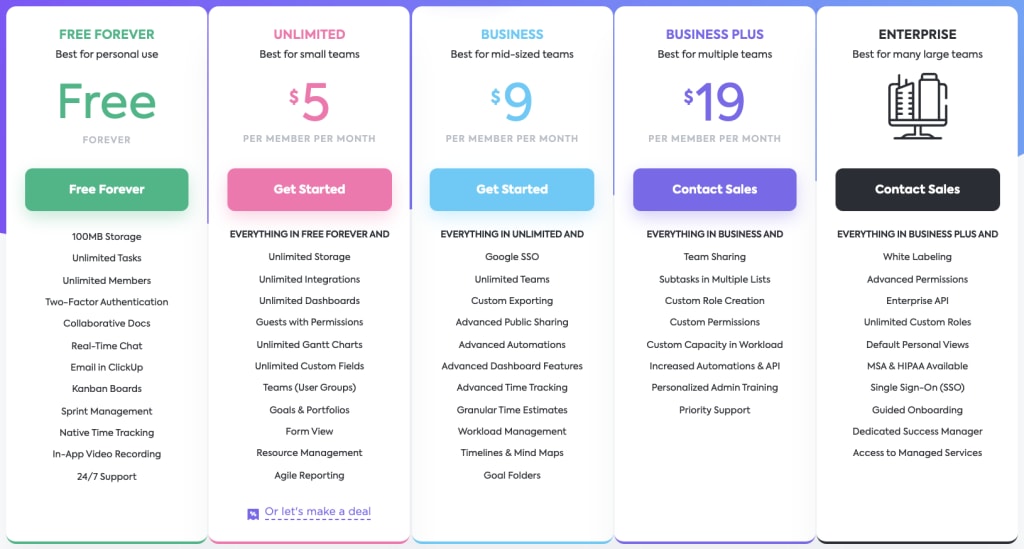
The Unlimited plan opens up the vast majority of ClickUp’s huge feature list, except for a few collaboration, customisation and reporting features. The Business plan allows you to create unlimited teams and opens up advanced automations, time tracking and workload management features. The Business Plus plan gives you access to all of ClickUp’s collaboration features and unlocks most customisation options with the main exception being white-labelling.
This is available on the Enterprise plan, which also gets you the full set of security and support features provided by ClickUp.
What is ClickUp good for?
ClickUp has developed one of the most collaborative project planning and management systems we’ve ever used and also one of the most usable. Most platforms that push this hard on collaboration end up creating a convoluted system swamped with features that interrupt your workflow more than they enhance it. This isn’t the case with ClickUp, largely thanks to the excellent UI design that intuitively separates features so you can find everything easily.
A depth of customisation options also allows you to basically remove anything you don’t want clogging up the interface.
As a marketing planning tool, ClickUp offers more than you would normally expect from a system primarily designed for project management, too. Aside from marketing and agile management templates, you get dedicated tools for planning sprint runs, a wealth of views to plan workloads and goal tracking so you can measure performance.
What is ClickUp missing?
ClickUp offers so many features it’s hard to imagine anything could be missing but we have to remember this isn’t a platform built with marketing planning specifically in mind. If we’re comparing this to TrueNorth and MarketPlan, you’re not getting the projection and simulation features we explored with the other two or the campaign ideation features available on TrueNorth.
Despite this, the wealth of collaboration features available in ClickUp should provide more than enough to help your team develop marketing ideas effectively.
Aside from lacking some of the more advanced marketing planning features provided by TrueNorth and MarketPlan, ClickUp competes with all of the other systems we’ve looked at in this platform. It’s as good as the likes of monday.com for project management and offers a greater depth of marketing-specific features than the more project-oriented tools.
ClickUp pros & cons
ClickUp pros
- Collaboration: ClickUp provides one of the most collaborative systems we’ve used without compromising productivity.
- Usability Despite the depth of features worked into its platform and the extent of collaboration tools, the standard of usability ClickUp achieves is impressive.
- Marketing planning: While it doesn’t compete with TrueNorth and MarketPlan when it comes to marketing planning, ClickUp offers more in this regard than the other alternatives.
ClickUp cons
- Mobile apps: As good as the web app experience is, the UI design on the mobile apps isn’t as intuitive.
- Learning curve: The depth of features comes with an inevitable learning curve that you’re not going to get from simpler tools like Trello.
ClickUp verdict
ClickUp is a collaborative project management system that doubles up as an excellent marketing planning system. While it doesn’t match the advanced features of TrueNorth and MarketPlan, it comes closer than any of the other platforms we’ve looked at in this article while competing with the best project management systems like monday.com and Trello.
The web app is a joy to use thanks to the quality of its UI design and it’s genuinely impressive how usable this system is, considering how many features are squeezed into the platform. It’s just a shame the UX of the mobile apps isn’t as strong but it was always going to be a challenge to scale this kind of software into a mobile experience.
Which is the best marketing planning software?
We’ve looked at a lot of software platforms in this article and they all take a different approach to marketing planning. Some are designed specifically for planning campaigns and strategies while others are more general-purpose project planning tools – and they all come in at different price points.
To help you choose the best marketing planning system for your needs, we’re now going to compare them on the following characteristics:
- Pricing
- Marketing planning features
- Usability
First, we see which is the best-value marketing planning tool by comparing the pricing of each software product and, then, we compare the key features they each offer to see what you’re getting for your money. Finally, we talk about which platforms deliver the best user experience, which is particularly important for software you’re going to use on a daily basis.
Which is the best-value marketing planning tool?
To determine which marketing planning systems offer the best value, we’ve put together a comparison table showing which ones offer a free plan, the price you can expect to pay for the cheapest paid plan and the starting price for the most expensive plan they offer.
| Tool | Free plan? | Starting price | Top plan |
|---|---|---|---|
| TrueNorth | – | $99/mo | – |
| MarketPlan | Yes | $9/mo | $79 |
| CoSchedule | Yes | $29/mo | POA |
| monday.com | Yes | £21/mo | £42/mo |
| Airtable | Yes | $10/mo | $20/mo |
| Trello | Yes | $5/mo | $17.40/mo |
| ClickUp | Yes | $5/mo | $19/mo |
All of the products featured in this article offer a free plan, except for TrueNorth which opts for a 30-day free trial for you to test out the platform. The downside of this is you only get 30 days to decide whether the platform is right for you but the benefit of a free trial is that you get access to all of the features, instead of a restricted free plan, which allows you to make a decision on the system’s full capabilities – no guesswork required.
A couple of other things to note about TrueNorth: first, it doesn’t charge on a per-user basis and, secondly, there are no upgrade plans – you simply pay $99/month for your whole team and all of TrueNorth features.
The rest of the platforms are all priced on a per-user basis so even the $9/month starting price for MarketPlan costs you $108/month for a team of 12 people and you’re not even getting its best features.
If you’re looking for a personal marketing planning tool as a solopreneur, then the free and starter plans from the likes of MarketPlan and CoSchedule are excellent value. However, for teams that are looking for a complete marketing planning and management system, you won’t find better value than TrueNorth’s flat pricing model.
Which is the best marketing planning tool for features?
To illustrate how each platform approaches marketing planning, we’ve also put a table together showing the defining features they all offer. Here, you can see a clear pattern with the products designed specifically for planning marketing strategies and the more general-purpose project planning/management tools.
| Tool | Marketing planning | Templates | Forecasting | Campaign tracking | Asset mngmnt |
|---|---|---|---|---|---|
| TrueNorth | ✔ | – | ✔ | ✔ | – |
| MarketPlan | ✔ | – | ✔ | ✔ | – |
| CoSchedule | – | ✔ | – | – | ✔ |
| monday.com | – | ✔ | – | – | ✔ |
| Airtable | – | ✔ | – | – | ✔ |
| Trello | – | – | – | – | – |
| ClickUp | * | ✔ | – | – | – |
TrueNorth and MarketPlan are the only platforms that offer comprehensive marketing planning features, such as collaborative ideation and funnel mapping. They’re also the only two systems that deliver campaign forecasting features so you can predict outcomes and dedicated campaign tracking so you can measure the performance of live campaigns.
With the other platforms, marketing planning mainly revolves around the use of templates and planning team workloads. ClickUp does offer some unique features for planning sprints and, although they’re more designed for planning development sprints, they’re perfectly suitable for developing marketing sprints.
If you’re looking for a pure marketing planning system, then TrueNorth and MarketPlan are the clear winners but the other platforms offer more in terms of project and workload management.
Which is the best for usability?
The purpose of this article is to help you choose the best marketing planning tool for your needs and usability is always a priority for this type of software. The rapid demands of modern marketing are too intense for the traditional, more time-consuming approaches to marketing planning so you can’t let unintuitive software slow you down even further.
We always look at four key characteristics when we test out new software to judge the quality of user experience:
- Smooth operation: The software runs smoothly without any lags or slowdowns as you interact with elements.
- Navigation: Elements, tools, settings and everything else you interact with is easy to find.
- Minimal clicks: Simple actions require no more than 1-3 clicks to complete and more complex actions (eg: settings changes) within a reasonable number of clicks.
- Action completions: The quantity of meaningful actions you complete vs time spent interacting directly with the software.
Essentially, we want software that provides features and tools that empower us to do more with our existing resources and a user experience that helps us use them effortlessly without getting in our way. From the systems we’ve looked at in this article, three platforms stand out in meeting these criteria with excellent UX design.
TrueNorth
As the newest product in our recommendations for this article, you would hope TrueNorth delivers a fresh, modern experience – and the platform doesn’t disappoint. With clean interfaces and intuitive navigation, the system is easy to learn and you won’t find yourself digging around menus trying to find specific features or tools.
TrueNorth incorporates a lightweight collaboration system that helps team members create better marketing ideas without bombarding everyone with notifications (ie: distractions). People can develop ideas by themselves or call on teammates to help them out and managers can create timed ideation sessions for teams of any size.

TrueNorth is carefully designed to remove productivity drains, such as open instant messaging and pop-up notifications that distract people from their workflow.
It’s also optimised to minimise the number of clicks required to complete tasks in the software so you’re not wasting time with repetitive tasks or fiddling with settings. TrueNorth’s marketing focus benefits the user experience further by simplifying certain functionalities, such as the campaign management features.
Instead of having multiple views, project types and templates to deal with, you have a single Timeline view designed specifically for planning and managing marketing campaigns.
ClickUp
ClickUp is almost the polar opposite of TrueNorth as a marketing planning tool, primarily serving as a project management system that includes just enough specialist marketing features to earn a spot among our top recommendations.
That being said, the one clear similarity ClickUp shares with TrueNorth is the quality of its user experience. Visually speaking, the platforms have a lot in common and the navigational system between interfaces is generally very similar, too.
ClickUp doesn’t take the same minimal approach to product design as TrueNorth, though. You’ve got a lot of features crammed into this system, including a native Docs and collaboration system, instant chat, notifications and a bunch of views to navigate.
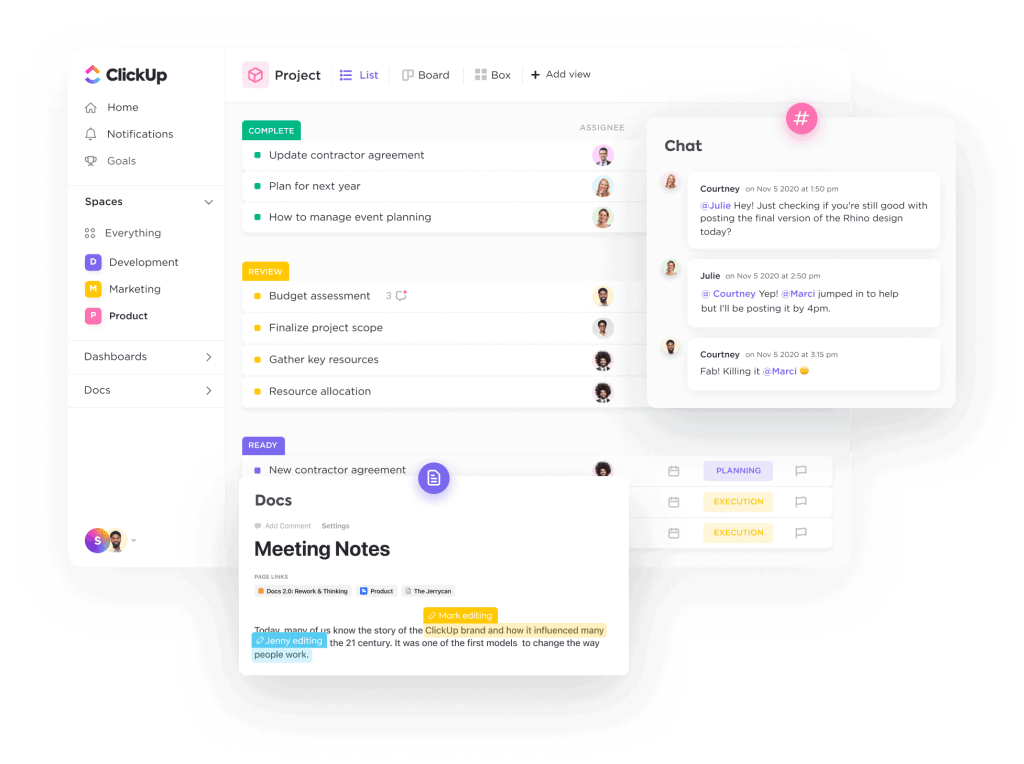
The downside to all of this functionality is the software can demand a lot of your time and you have to take care with features like instant chat to prevent it from becoming a productivity killer. However, the ClickUp UX is intuitive and the performance is basically flawless, even when you’re using its more resource-hungry features, such as real-time document collaboration.
We’ve looked at a few project management systems in this article that can double up as a marketing planning tool and ClickUp is the clear winner among them for usability.
Trello
Trello is another project management system and it earns a place among our top recommendations for usability thanks to some solid UX design, enhanced by the relative simplicity of its platform.

To be clear, you’re not getting much in the way of marketing planning features other than some marketing templates on the paid plan but usability is Trello’s biggest strength and it deserves credit for developing a simple, effective project planning/management tool.
Plan your way to marketing success
With the range of marketing planning systems we’ve looked at today, you should find the right tool (or combination of tools) for your team. As stated during the intro of this article, there’s a real lack of out-and-out marketing planning software available but we’ve looked at the two top systems on the market in TrueNorth and MarketPlan, plus the best project management systems that may not have the same depth of marketing features but offer more flexibility in planning a wide range of project types.
Now, it’s over to you to test some of the products out for yourself and decide which marketing planning system is going to help your team develop winning campaigns.




